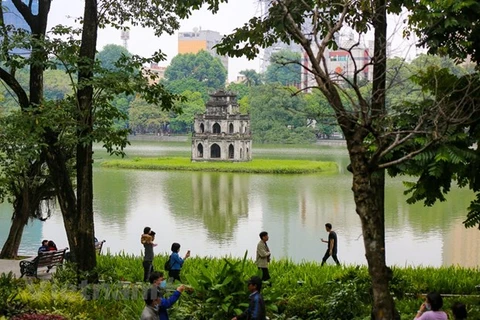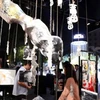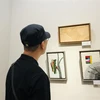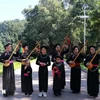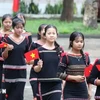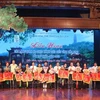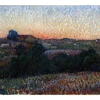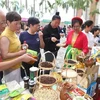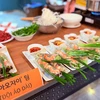 The season of giant crape myrtle (lagerstroemia) indicates that a brilliant summer has come. Despite blooming for a short time, the bright purple of giant crape myrtle brings a poetic beauty to the capital city of Hanoi in the early summer days. As the giant crape myrtle is in full bloom, students are reminded that summer is around the corner, and it is time to say farewell to schools and friends. The blossoms have dozens of silky petals, and usually bloom from early May till late June when the weather turns hot with some heavy rains. The giant crape myrtle is always blooming into large clusters, each have dozens of little purple blossoms. (Photo: VietnamPlus)
The season of giant crape myrtle (lagerstroemia) indicates that a brilliant summer has come. Despite blooming for a short time, the bright purple of giant crape myrtle brings a poetic beauty to the capital city of Hanoi in the early summer days. As the giant crape myrtle is in full bloom, students are reminded that summer is around the corner, and it is time to say farewell to schools and friends. The blossoms have dozens of silky petals, and usually bloom from early May till late June when the weather turns hot with some heavy rains. The giant crape myrtle is always blooming into large clusters, each have dozens of little purple blossoms. (Photo: VietnamPlus)  The beautiful flowers without fragrance still sing their silent songs under the sunlight and blue sky, making up a lively painting of summer. Giant crape myrtle trees are often planted along the roads to cool down the heats on crowded streets in the capital city of Hanoi. If you are now driving along the streets, you will encounter the familiar purple color, just slow down a bit to enjoy its unique beauty! There are quite a few streets in Hanoi that grow this plant, such as Giai Phong road or some Hanoi’s old streets of Tho Nhuom, Kim Ma, Tay Son, and Dao Tan, among others. (Photo: VietnamPlus)
The beautiful flowers without fragrance still sing their silent songs under the sunlight and blue sky, making up a lively painting of summer. Giant crape myrtle trees are often planted along the roads to cool down the heats on crowded streets in the capital city of Hanoi. If you are now driving along the streets, you will encounter the familiar purple color, just slow down a bit to enjoy its unique beauty! There are quite a few streets in Hanoi that grow this plant, such as Giai Phong road or some Hanoi’s old streets of Tho Nhuom, Kim Ma, Tay Son, and Dao Tan, among others. (Photo: VietnamPlus)  Giant crape myrtle flowers have many different colours such as light purple, pink purple or white-pale-purple, but the trees grown in Hanoi usually have dark purple flowers. There are quite a few streets in Hanoi that grow this plant, such as Giai Phong road or some Hanoi’s old streets such as Tho Nhuom, Kim Ma, Tay Son, and Dao Tan, among others. The flowers can enchant many romantic souls that the “Bang Lang tim” (giant crape myrtle) has starred in many poems and songs about Hanoi. Then, purple color of the flowers turns Hanoi streets to be chic and unique in the summer, a scene that everyone who live far away the city would regret for missing it. (Photo: VietnamPlus)
Giant crape myrtle flowers have many different colours such as light purple, pink purple or white-pale-purple, but the trees grown in Hanoi usually have dark purple flowers. There are quite a few streets in Hanoi that grow this plant, such as Giai Phong road or some Hanoi’s old streets such as Tho Nhuom, Kim Ma, Tay Son, and Dao Tan, among others. The flowers can enchant many romantic souls that the “Bang Lang tim” (giant crape myrtle) has starred in many poems and songs about Hanoi. Then, purple color of the flowers turns Hanoi streets to be chic and unique in the summer, a scene that everyone who live far away the city would regret for missing it. (Photo: VietnamPlus)  Only a few days after blooming, the colours of giant crape myrtle flowers will fade and then finally they fall from their branches. The purple flowers flaunt their exquisite beauty, evoking the emotions and memories of people. Each season in Hanoi has its own distinctive flowers. The season of giant crape myrtle flowers indicates that a brilliant summer has come. Leaving the gloomy and drizzling days behind, the capital city has re-encountered its usual summer vibrancy with purple giant crape myrtle flowers blossoming all over the streets. The purple flowers make the city more pleasant on the scorching sun. The blossoms have dozens of silky petals, and usually bloom from early May till late June. (Photo: VietnamPlus)
Only a few days after blooming, the colours of giant crape myrtle flowers will fade and then finally they fall from their branches. The purple flowers flaunt their exquisite beauty, evoking the emotions and memories of people. Each season in Hanoi has its own distinctive flowers. The season of giant crape myrtle flowers indicates that a brilliant summer has come. Leaving the gloomy and drizzling days behind, the capital city has re-encountered its usual summer vibrancy with purple giant crape myrtle flowers blossoming all over the streets. The purple flowers make the city more pleasant on the scorching sun. The blossoms have dozens of silky petals, and usually bloom from early May till late June. (Photo: VietnamPlus)  Giant crape myrtle is a native plant of India, hence its other name, Pride of India. It has been grown in many places in the capital city of Hanoi. The flower has been considered the symbol of the capital city, signaling the arrival of summer. The purple flowers make the city more pleasant on the scorching sun. After full bloom, the giant crape myrtle flowers begin to fade and finally fall off from their branches. The purple color of the flowers turns Hanoi streets to be chic and unique in the summer, a scene that everyone who live far away the city would regret for missing it. (Photo: VietnamPlus)
Giant crape myrtle is a native plant of India, hence its other name, Pride of India. It has been grown in many places in the capital city of Hanoi. The flower has been considered the symbol of the capital city, signaling the arrival of summer. The purple flowers make the city more pleasant on the scorching sun. After full bloom, the giant crape myrtle flowers begin to fade and finally fall off from their branches. The purple color of the flowers turns Hanoi streets to be chic and unique in the summer, a scene that everyone who live far away the city would regret for missing it. (Photo: VietnamPlus)  In May, when the sound of cicadas signals the advent of summer, giant purple crape myrtle flowers bloom in many streets of Hanoi. The purple flowers have been a symbol of the city, and make people nostalgic. It is also known in English as the Pride of India, a gracious nod to its place of origin, certainly one of that country’s more notable flora exports. This flowering tree, which is native to tropical southern Asia, has been honored and celebrated in numerous Vietnamese songs and poems. Like other trees in Hanoi and other cities, these giant crape myrtle trees are both aesthetically pleasing and tough as nails. (Photo: VietnamPlus)
In May, when the sound of cicadas signals the advent of summer, giant purple crape myrtle flowers bloom in many streets of Hanoi. The purple flowers have been a symbol of the city, and make people nostalgic. It is also known in English as the Pride of India, a gracious nod to its place of origin, certainly one of that country’s more notable flora exports. This flowering tree, which is native to tropical southern Asia, has been honored and celebrated in numerous Vietnamese songs and poems. Like other trees in Hanoi and other cities, these giant crape myrtle trees are both aesthetically pleasing and tough as nails. (Photo: VietnamPlus)  A sea of yellow has descended on the streets around Ho Tay (West Lake), in the capital city of Hanoi in recent days thanks to the blossoming of colourful Muong Hoang Yen, also known as golden shower trees, which mark the beginning of summer. The flowers of the golden shower trees, scientifically known as Cassia fistula, are beginning to bloom and fill the streets of Hanoi with a vibrant yellow colour. Each branch holds around five buds which contain oval shaped petals. The yellow buds form in bunches measuring between 20 and 40 centimetres. The golden shower is the national flower of Thailand. (Photo: VietnamPlus)
A sea of yellow has descended on the streets around Ho Tay (West Lake), in the capital city of Hanoi in recent days thanks to the blossoming of colourful Muong Hoang Yen, also known as golden shower trees, which mark the beginning of summer. The flowers of the golden shower trees, scientifically known as Cassia fistula, are beginning to bloom and fill the streets of Hanoi with a vibrant yellow colour. Each branch holds around five buds which contain oval shaped petals. The yellow buds form in bunches measuring between 20 and 40 centimetres. The golden shower is the national flower of Thailand. (Photo: VietnamPlus)  Together with giant crape myrtle and flamboyant flowers, golden shower trees help make the summer more colourful and the streets feel far more poetic. The flowers can be seen in full bloom from May until July. The city’s streets look increasingly beautiful as they are adorned with the yellow blossoms. Under the sun of summer, bunches of blooming yellow golden shower flowers add a brilliant glow to many streets in Hanoi. A golden shower tree is 10m-20m tall with a diameter of 40cm. These days, the West Lake, a famous scenic spot in the capital city, is covered in the bright yellow color of flowers from the golden shower tree. (Photo: VietnamPlus)
Together with giant crape myrtle and flamboyant flowers, golden shower trees help make the summer more colourful and the streets feel far more poetic. The flowers can be seen in full bloom from May until July. The city’s streets look increasingly beautiful as they are adorned with the yellow blossoms. Under the sun of summer, bunches of blooming yellow golden shower flowers add a brilliant glow to many streets in Hanoi. A golden shower tree is 10m-20m tall with a diameter of 40cm. These days, the West Lake, a famous scenic spot in the capital city, is covered in the bright yellow color of flowers from the golden shower tree. (Photo: VietnamPlus)  This species grows well in sunny and well-drained areas, although it is tolerant of drought and salinity. Rows of golden shower trees along the West Lake are in full bloom. Young people come here to take pictures, and wear masks to prevent the spread of the COVID-19 pandemic. The flowers have five yellow petals of equal size and shape. In Vietnam, this species grows wild in forests in the Central Highlands provinces such as Gia Lai, Kon Tum, Dak Lak, and Dak Nong. It is also grown in many cities such as Nha Trang, Da Lat, Da Nang and Ho Chi Minh City. (Photo: VietnamPlus)
This species grows well in sunny and well-drained areas, although it is tolerant of drought and salinity. Rows of golden shower trees along the West Lake are in full bloom. Young people come here to take pictures, and wear masks to prevent the spread of the COVID-19 pandemic. The flowers have five yellow petals of equal size and shape. In Vietnam, this species grows wild in forests in the Central Highlands provinces such as Gia Lai, Kon Tum, Dak Lak, and Dak Nong. It is also grown in many cities such as Nha Trang, Da Lat, Da Nang and Ho Chi Minh City. (Photo: VietnamPlus)  Each branch of golden shower trees holds around five buds which contain oval shaped petals. The flowers can be seen in full bloom from May until July. The tree, with its scientific name of Cassia fistula, has abundant racemes of bright yellow flowers. A golden shower tree is 10m-20m tall with a diameter of 40cm. It is considered the national flower of Thailand with the name of dokkhuen. Its yellow flowers symbolize Thai royalty. Together with bang lang (giant crape myrtle) and phuong vi (flamboyant flower), golden shower trees make the summer in the capital city of Hanoi more colourful and the streets more poetic. (Photo: VietnamPlus)
Each branch of golden shower trees holds around five buds which contain oval shaped petals. The flowers can be seen in full bloom from May until July. The tree, with its scientific name of Cassia fistula, has abundant racemes of bright yellow flowers. A golden shower tree is 10m-20m tall with a diameter of 40cm. It is considered the national flower of Thailand with the name of dokkhuen. Its yellow flowers symbolize Thai royalty. Together with bang lang (giant crape myrtle) and phuong vi (flamboyant flower), golden shower trees make the summer in the capital city of Hanoi more colourful and the streets more poetic. (Photo: VietnamPlus)  Golden shower trees or Cassia fistula (botanical name) are in full bloom this time of year in Hanoi with incredible cascading yellow flower clusters that sometimes are so prolific one can barely see the green leaves. Throughout Southeast Asia the fistula is revered both for its beauty and for its medicinal properties in combating a large variety of ailments, from colds to stomach ailments to skin disorders. The fistula is a member of the pea or legume family, which means that their seeds are contained in elongated pods. It also happens to be the national flower of Thailand. This time of year, their showy yellow flowers are a delight that brighten up the landscapes throughout the capital city of Hanoi. (Photo: VietnamPlus)
Golden shower trees or Cassia fistula (botanical name) are in full bloom this time of year in Hanoi with incredible cascading yellow flower clusters that sometimes are so prolific one can barely see the green leaves. Throughout Southeast Asia the fistula is revered both for its beauty and for its medicinal properties in combating a large variety of ailments, from colds to stomach ailments to skin disorders. The fistula is a member of the pea or legume family, which means that their seeds are contained in elongated pods. It also happens to be the national flower of Thailand. This time of year, their showy yellow flowers are a delight that brighten up the landscapes throughout the capital city of Hanoi. (Photo: VietnamPlus)  Flamboyant trees, also called royal Poinciana and flame trees, are a familiar sight in Vietnam and called "the flower of school age" because it starts to bloom when the academic year ends. The species originated in Madagascar and was planted in Vietnam by the French in the 19th century. Hanoi’s streets, parks and lakes are adorned with the burning red of flamboyant flowers in June. Flamboyant flowers are in full bloom in many roads and lakes such as West Lake, Truc Bach Lake, and To Lich River in the summer. Flame tree flowers are considered the iconic flora of summer in Hanoi. The variety blooms from April to June annually. (Photo: VietnamPlus)
Flamboyant trees, also called royal Poinciana and flame trees, are a familiar sight in Vietnam and called "the flower of school age" because it starts to bloom when the academic year ends. The species originated in Madagascar and was planted in Vietnam by the French in the 19th century. Hanoi’s streets, parks and lakes are adorned with the burning red of flamboyant flowers in June. Flamboyant flowers are in full bloom in many roads and lakes such as West Lake, Truc Bach Lake, and To Lich River in the summer. Flame tree flowers are considered the iconic flora of summer in Hanoi. The variety blooms from April to June annually. (Photo: VietnamPlus)  The flamboyant flowers are familiar with students across the country as the trees are planted extensively in school yards. The blooming flowers signal the end of the school year. This flower has four petals with red-orange or magenta. Flamboyant flowers have burst into full bloom in every corner of Hanoi, dying the city a brilliant red. Flamboyant flowers were brought to Vietnam by the French in the 19th century. They are now planted in almost all provinces and cities across Vietnam. In Hanoi, Thanh Nien Street, Truc Bach Lake, West Lake and Lang Street are among the most beautiful places to admire flamboyant flowers. (Photo: VietnamPlus)
The flamboyant flowers are familiar with students across the country as the trees are planted extensively in school yards. The blooming flowers signal the end of the school year. This flower has four petals with red-orange or magenta. Flamboyant flowers have burst into full bloom in every corner of Hanoi, dying the city a brilliant red. Flamboyant flowers were brought to Vietnam by the French in the 19th century. They are now planted in almost all provinces and cities across Vietnam. In Hanoi, Thanh Nien Street, Truc Bach Lake, West Lake and Lang Street are among the most beautiful places to admire flamboyant flowers. (Photo: VietnamPlus) VNA


